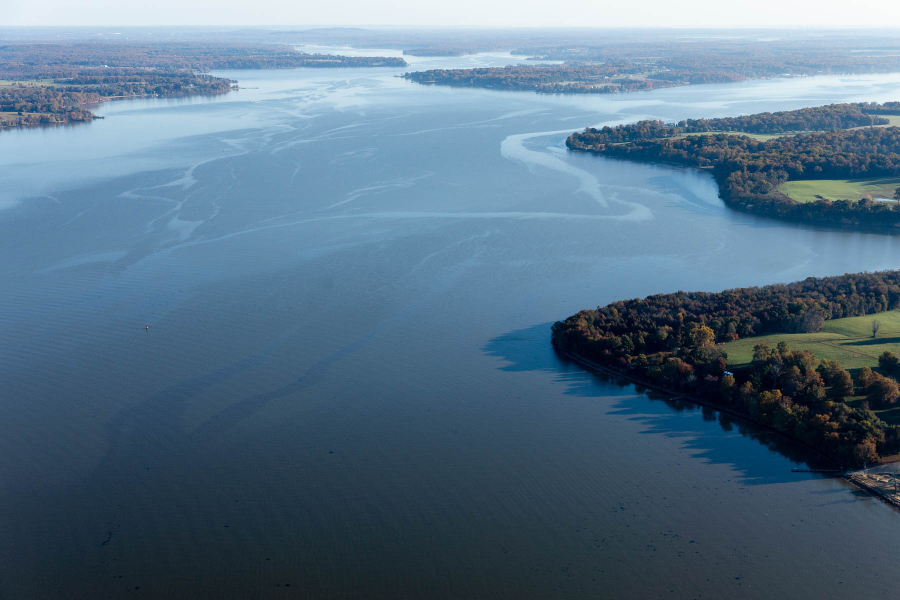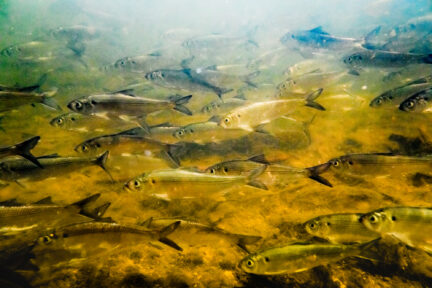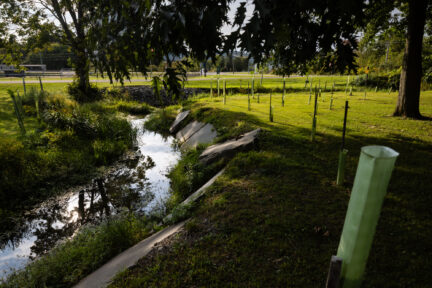The 2023 Chesapeake Bay dead zone is the smallest on record
The combination of pollution reduction practices and below-average rainfall results in a historically small dead zone

This year, the Chesapeake Bay’s summer “dead zone” was the smallest it’s been since monitoring began in 1985, according to data released by the Chesapeake Bay Program’s monitoring partners: The Maryland Department of Natural Resources (MD DNR), Old Dominion University and Virginia Institute of Marine Science (VIMS).
“These results illustrate that nutrient input reductions can produce a significant improvement for fish, crab and oyster habitats, and that we need to continue and advance our management efforts throughout the watershed," said Mark Trice, program chief of water quality informatics with MD DNR’s Resource Assessment Service.
Dead zones are areas of low oxygen (less than 2 milligrams per liter oxygen) that form in deep Bay waters when nitrogen and phosphorus (nutrients) enter the water through polluted runoff and feed naturally-occurring algae. This drives the growth of algal blooms, which eventually die and decompose, removing oxygen from the surrounding waters faster than it can be replenished. This creates low-oxygen—or hypoxic—conditions at the bottom of the Bay that limit habitat for crabs, oysters, fish and other wildlife.
Based on water quality data provided by MD DNR, the Virginia Department of Environmental Quality and Old Dominion University, MD DNR and VIMS individually estimated the size of the dead zone from May to October 2023 using separate methods. They then calculated hypoxic volume within the Bay’s mainstem from that time period. The MD DNR found that hypoxic water volume averaged 0.52 cubic miles, while VIMS reported a similarly low estimate of 0.58 cubic miles. Both estimates are the lowest on record and much lower than the historical average of 0.97 cubic miles taken from 1985-2022. These findings also align with the forecast released in June 2023, which predicted a 33% smaller than average dead zone.
According to MD DNR’s report, dissolved oxygen was better than average in May through August 2023, with early August having the lowest volume of hypoxia ever calculated during that time period. The dead zone was larger than average in September, but observations showed no hypoxic conditions in October. For the past four years, the summer dead zone has been below the long-term average size, as documented both by VIMS and MD DNR.
Rainfall plays an important role in the development of dead zones, as it washes nutrients from the land into the Bay. Precipitation was below-average for most of 2023—estimates from the United States Geological Survey (USGS) show that freshwater flowing into the Bay was below average from October 1, 2022—September 30, 2023, with 65,649 cubic feet of water per second compared to the long-term average of 79,000 cubic feet per second. In June, freshwater flows were in the historical lowest 25th percentile.
The 2023 dead zone could have been even smaller if it weren’t for the season’s above average temperatures and average wind speeds. Warmer air leads to warmer Bay waters, which in turn hold less oxygen and support higher rates of oxygen consumption by microorganisms. Faster wind speeds help mix oxygen into the deeper waters of the Bay, which can prevent hypoxic conditions. Maryland’s monthly average air temperatures were above average from June through September 2023, ranking it as the 29th hottest in 129 years, while winds were near average during the summer.
“The low levels of hypoxia in 2023, despite the high temperatures, are truly surprising,” said Dr. Marjy Friedrichs, research professor at the Virginia Institute of Marine Science. “This may finally be clear evidence that our nutrient reduction strategies are improving water quality and fish and shellfish habitats.”
In addition to the weather conditions, the size and duration of the Bay's dead zone is affected by the amount of nutrients entering the Chesapeake from its surrounding watershed. Pollution-reducing practices put into place by Delaware, Maryland, New York, Pennsylvania, Virginia, West Virginia and the District of Columbia, help reduce the amount of nutrients that enter local waterways and the Chesapeake Bay from sources such as wastewater, agriculture and stormwater runoff. It is estimated that between 2009 and 2022, the six watershed states and the District of Columbia have met 51% of the goal to reduce nitrogen and 60% of the goal to reduce phosphorus by 2025.
Two reports are available based on these data: the Virginia Institute of Marine Science in their 2023 Chesapeake Bay Dead Zone Report Card, as well as the Maryland Department of Natural Resources in their 2023 Final Hypoxia Report.
"This year's Chesapeake Bay dissolved oxygen conditions are the best on record, and it is encouraging news,” said Sec. Josh Kurtz of the Maryland Department of Natural Resources, who is also Chair of the Chesapeake Bay Program’s Principal Staff Committee. “These results show that the ongoing work to reduce pollution across the Bay’s watershed is making the Chesapeake Bay a better place for fish, crabs, oysters, and other marine life. As we focus our cleanup efforts during the next decade, we can accelerate and build on this progress.”



